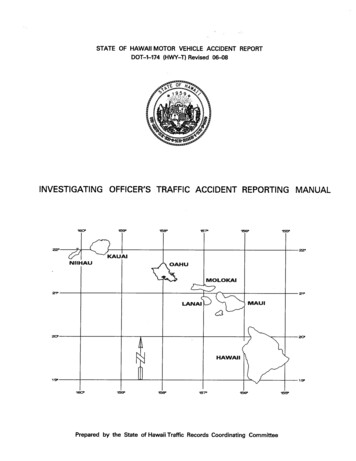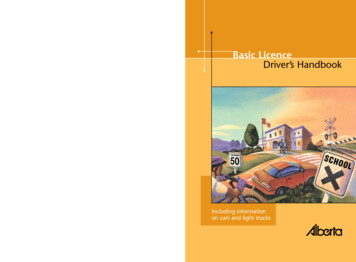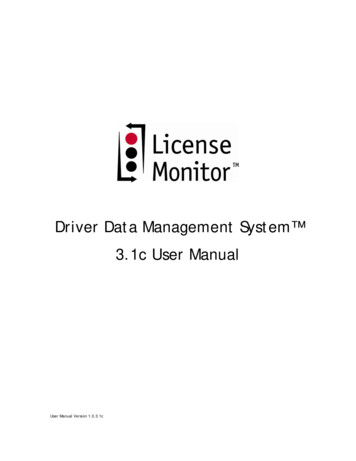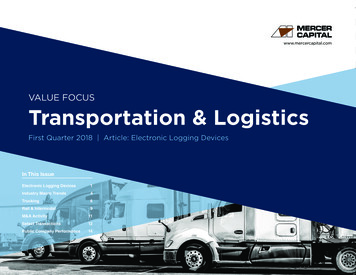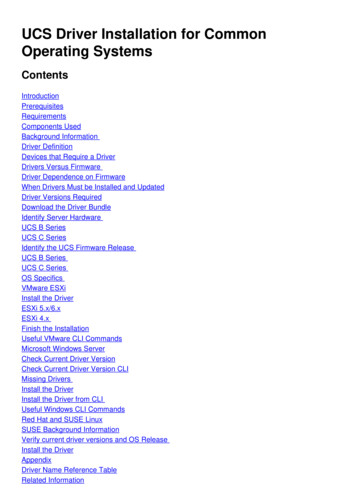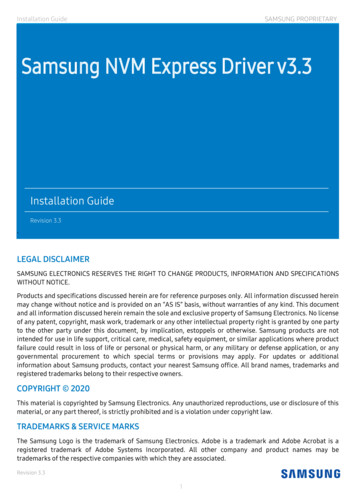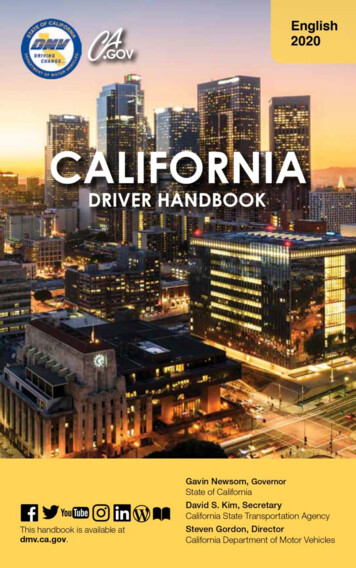
Transcription
English2020Gavin Newsom, GovernorState of CaliforniaDavid S. Kim, Secretary YoulD@)fffl@ California State TransportationThis handbook is available atdmv.ca.gov.AgencySteven Gordon, DirectorCalifornia Department of Motor Vehicles
THIS PAGE LEFTINTENTIONALLY BLANK
fjDear fellow Californian,We have more licensed drivers and registered vehicles than any otherstate. That means California’s roads pose unique challenges for drivers,cyclists and pedestrians. But when we follow the rules of the road anddrive with safety in mind at all times, everyone benefits.That is why this California Driver Handbook is so important. Withinthese pages – and online at DMV.ca.gov – you will find informationand advice to safely travel the roads of our great state. Whether you area young driver going over this material for the first time or refreshingyour knowledge after years of on-the-road experience, I hope you find thecontents informative, helpful, and practical.Yes, California’s traveling environment poses unique challenges – fromthe coasts to the mountains and everywhere in between. While we mayencounter varying conditions as we move throughout the state, the lawson how to reach our destination safely do not.Please be safe when you’re behind the wheel and remember to put awayyour smartphone while driving.Sincerely, j/ju-ifDAV I D S. K I MSecretaryCalifornia State Transportation Agency–i–
THIS PAGE LEFTINTENTIONALLY BLANK– ii –
TABLE OF CONTENTSNEW 2020 LAWS.VIDMV INFORMATION . VIIIWhere to Write .ixGENERAL INFORMATION. 1Disclaimer . 1DMV’s Function and Vision. 1Accurate Identification . 1Basic Information . 2THE CALIFORNIA DRIVER LICENSE . 2Who Must Have a Driver License? . 2California Residents. 2California Resident MilitaryPersonnel (U.S. Armed Forces) . 2Nonresident Military PersonnelStationed in California. 3New California Residents . 3Adults Visiting California. 3Safety for the Aging Driver. 3OBTAINING A DRIVER LICENSE . 4REAL ID Act. 5How the REAL ID Act ImpactsCalifornians . 5Do I Need a REAL ID? . 5How Do I Prepare to Apply for aREAL ID Card?. 5Married, Divorced, or NameChange?. 6Application Requirements for a BasicClass C Driver License . 6Adults’ Permit Requirements . 7Adults’ Driver License Requirements . 8DRIVER LICENSE CLASSES . 9THE EXAMINATION PROCESS .10Where to Take the Tests.10DMV Examinations .11Cheating.12SPECIAL SECTION – MINORS. 12Minors’ Permit Requirements .12Minors’ Permit Restrictions.13Minors’ Driver LicenseRequirements .13Exceptions – Minors’ Driver LicenseRestrictions.14Out-Of-State Minors .15Out-Of-State Minors’ Permit.15Out-Of-State Minors’ DriverLicense.15Actions Against the Provisional DriverLicense.15Keeping Your Provisional DriverLicense.16Minors and Cell Phones .16MISCELLANEOUS LICENSINGINFORMATION.17To Replace a Lost/Stolen or DamagedDriver License.17Name Changes.17Gender Category Changes .17Driver License Renewals.18Renewal by Mail or Internet.18Driver License Extension .18Driver License in Your Possession . 20Address Changes . 20Vision . 20Medical Information Card . 20Organ and Tissue Donation .21Veteran Designation and BenefitInformation .21How Can I Get VeteransDesignation?.21Register To Vote . 22Unlicensed Drivers. 22Diplomatic Driver Licenses. 22Identification (ID) Cards . 22No-Fee ID Cards . 23Identification (ID) Card Renewal byMail or Internet. 23Driving Schools. 23Mature Driver Program.24Pedestrian Responsibilities .24New Technology .25OCCUPANT PROTECTION. 26Seat Belts. 26Child Restraint System and SafetySeats. 26Riding Safely with Air Bags .27Unattended Children in MotorVehicles.28Distracted Driving .28Hot Weather Risks .28TRAFFIC CONTROLS . 29Traffic Signal Lights . 29Pedestrian Signal Lights . 30Traffic Signs.31– iii –
LAWS AND RULES OF THE ROAD . 34Right-of-Way Rules. 34General Information . 34Pedestrians. 34Crosswalks . 35Intersections . 35Roundabouts . 36On Mountain Roads .37Speed Limits.37Reduced Speeds .37VISUAL SEARCH. 42Scanning .42Know What Is Ahead.42Know What Is at Your Side. 43Know What Is Behind You. 44How Well Can You Stop? . 45LANE CONTROL. 46Line Colors . 46Choosing a Lane.47Changing Lanes.47Passing Lanes .47Carpool/High-Occupancy Vehicles(HOV) Lanes . 48Center Left Turn Lanes . 48Turnout Areas and Lanes. 49End-of-Lane Markings . 49Yield Lines. 49Bicycle Lanes . 49TURNS. 50Examples of Right and Left Turns.52Legal U-Turns . 53Illegal U-Turns. 56PARKING . 56Parking on a Hill. 56Parallel Parking.57Parking at Colored Curbs. 58Illegal Parking . 59Special Parking Rules. 60SAFE DRIVING PRACTICES. 60Signaling . 60Steering.61Hand Position .61Controlling the Vehicle .61Horn, Headlights, and EmergencySignals . 62Use Your Horn . 62Do Not Use Your Horn . 62Use Your Headlights . 63Use Your Emergency Signals . 63Text Messaging and Cell Phones . 64VEHICLE POSITIONING . 66Following Distances. 66Persons Who Present Dangers toDrivers. 66Splitting the Difference.67Space to Merge .67Space to Cross or Enter .67Space to Exit . 68Passing . 68When Approaching to Pass . 68Returning to a Lane AfterPassing. 69Being Passed. 69SHARING THE ROAD . 70Large Trucks (Big Rigs) andRecreational Vehicles (RVs) .70Braking .70Trucker’s Blind Spots—the“No Zone” .70Turning .70Maneuverability.72Buses, Streetcars, and Trolleys .72Light-Rail Vehicles .73Emergency Vehicles .74Slow-Moving Vehicles.74Neighborhood Electric Vehicles (NEV)and Low-Speed Vehicles (LSV).75Animal-Drawn Vehicles.75Motorcycles .75Bicycles .76Bicycles in Travel Lanes . 77Pedestrians Who Are Blind . 80Road Workers and Work Zones(Cone Zones). 82Double Fine Zones. 82Move Over and Slow Down . 82Vehicles with Hazardous Loads. 83Dealing with Traffic Congestion. 83Dealing with Aggressive Drivers andRoad Rage . 83SPECIAL DRIVING SITUATIONS . 84Keep Your Car Visible . 84What is the Road Condition. 84Curves. 85Traffic Speeds . 85– iv –
Driving Hazards . 85Water on the Road . 85Slippery Roads . 85High Winds . 86Driving in Fog or Heavy Smoke . 86Driving With Sun Glare.87Driving in Darkness.87Driving in Rain or Snow. 88Flooded Roadways . 88Driving in Hill Country or Curves . 89Traffic Breaks. 89Clean Windows and Mirrors . 89Adjust Seat and Mirrors. 90Tire Safety . 90Green Driving . 90Other Dangers. 92What a Driver Should Do During anEnforcement Stop . 92HANDLING EMERGENCIES. 93Mechanical Tips. 93Skids on Slippery Surfaces . 93Driving Off the Pavement . 94Acceleration Skids . 94Locked Wheel Skids. 94Accelerator Malfunction. 95Steering Wheel Locking Device. 95Collisions Are Not Accidents . 95Causes of Collisions. 95Involved in a Collision . 95Reporting a Collision. 96Safety Tips .97On the Freeway .97On Railroad Tracks . 98DRIVER READINESS. 98Vision . 98Hearing. 98Fatigued or Drowsy Driving . 99Medications . 99Health and Emotions. 99Conditions Physicians Must Report . 100ALCOHOL AND DRUGS. 100Alcohol/Drugs and Driving IsDangerous. 100Use or Possession of Alcohol orCannabis Products in a Vehicle.101Drivers Under 21 (Possession ofAlcohol) .101Drivers of All Ages .101Blood Alcohol Concentration (BAC)Limits.102Admin Per Se .102Under 21—Zero Tolerance forAlcohol Use .103Court DUI Convictions .103Drivers 21 and Older—DUI Programsand Restricted Driver Licenses. 106ADDITIONAL DRIVINGLAWS/RULES . 106Things You Must Not Do:. 106Things You Must Do:.108ADMINISTRATIVE . 108Financial Responsibility.108Insurance Requirements .108Collisions on Your Record .109Collisions, Insurance, and Minors.109Getting a Ticket.110Evading a Peace Officer .110Points on the Driver Record . 111Traffic Violator School Convictions . 111Suspension or Revocation . 111Record Confidentiality.112Vandalism/Graffiti—All Ages.112Speed Contests/Reckless Driving .112Possessing Firearms .112Vehicle Registration Requirements.112California Vehicles .112Out-of-State Vehicles.113Vehicle Theft Prevention Tips.114ONLINE DRIVER LICENSE FAST FACTSAND OTHER PUBLICATIONS .115–v–
NEW 2020 LAWSEffective January 1, 2020SB 485 (Beall, Ch. 505, Stats. 2019)This law repeals provisions that authorize or require courts to suspend,revoke, or restrict a driver, or order the Department of Motor Vehicles(DMV) to delay licensure for a person convicted of prostitution or vandalism,a minor convicted of unlawful possession or use of a firearm, or offensesrelated to possession, purchase, sale, or transport of controlled substancesinvolving the use of a vehicle. The law also prohibits courts from orderingDMV to delay licensure, suspend, revoke, or restrict a person based upona conviction of minor’s possession/use of controlled substances or alcoholfor specified violations.AB 2918 (Holden, Ch. 723, Stats. 2018)This law requires the DMV to include information in the CaliforniaDriver Handbook regarding a person’s civil rights during a traffic stop,including the right to file a complaint against a peace officer, as specified.The following information was developed by the civil rights section of theDepartment of Justice in consultation with DMV, the California HighwayPatrol, the Commission on Peace Officer Standards and Training, and civilrights organizations:Your Rights During an Enforcement StopIf an officer asks your permission to do something, you have a right tosay no. However, if you say no and the officer says they are going to do itanyway, you do not have a right to interfere with their actions. For example,an officer may request to search part or all of your vehicle. You have a rightto decline that request, but the officer may have the legal authority to searchyour vehicle anyway under certain circumstances. If you do not want theofficer to search your vehicle, you should clearly say that you do not giveyour permission, but you do not have a right to resist or obstruct the officerif they search your vehicle anyway.The driver of a stopped vehicle must produce a driver license, proof ofinsurance, and vehicle registration when stopped by law enforcement. Ifa driver does not produce these documents, officers may conduct a limitedsearch for them. An officer may also request the names or identificationof passengers. Passengers can decline that request, but under somecircumstances the passengers may be required to identify themselvesanyway. If passengers do not want to produce their identification, theyshould clearly say so. Passengers should not interfere with the officer’s– vi –
duties in conducting the traffic stop, and if an officer demands identification,passengers should not interfere with the officer’s actions. During a trafficstop, an officer can legally require the driver and all passengers to exit orstay inside the vehicle–if you are told to exit the vehicle or stay inside, youmust do so.In California, only federal law enforcement officers can ask you aboutyour immigration status. California law prohibits state and local officersfrom asking drivers or passengers about their immigration status. If aCalifornia law enforcement officer asks you about your immigration status,you can decline to answer.In general, the First Amendment protects the right of drivers andpassengers to record interactions with police in public spaces. If you arerecording, you should immediately make that clear. You do not have a rightto interfere with the officer’s lawful duties during the enforcement stop, andyou should not reach into concealed areas to retrieve your recording devicewithout the officer’s permission. If your recording is not interfering with theofficer’s ability to lawfully do their job, an officer cannot confiscate yourrecording device, delete the recording, or destroy the device just because youare using it to record. In general, you also have the right to deny a requestto “unlock” a cellular phone or provide a password to it, though under somecircumstances–such as if you are on parole–you may have to give permissionin response to such requests. Finally, no government employee can retaliateagainst you just because you recorded something in public.Even if you believe your rights were violated, you should not engagein physical resistance or violence against the officer. If an officer doessomething that you believe violates your rights, you can voice your objection,but you should not physically resist. Everyone has the right to be safe duringa traffic stop; your safety and the officer’s safety could be jeopardized if thesituation escalates with physical resistance or violence.All members of the public have a right to file a complaint against anypeace officer or law enforcement agency, and it is against the law for anygovernment employee to retaliate against you for doing so. You can filea complaint with any agency that employs the officer, whether a sheriff’soffice, police department, or any other law enforcement agency. You havea right to be free from discrimination based on your actual or perceivedrace, sex, color, ethnicity, national origin, age, religion, gender identityor expression, sexual orientation, mental or physical disability, medicalcondition, or citizenship status. You also have other rights guaranteed bythe United States and California Constitutions, as well as California andfederal laws. When you file a complaint, the agency that employs the officermust investigate the complaint. Links to contact information for Californialaw enforcement agencies can be found at: https://post.ca.gov/le-agencies.– vii –
DMV INFORMATIONSome field offices may have extended hours and may be open on Saturdays,and a few offer only driver license or identification (DL/ID) card or vehicleregistration services. Behind-the-wheel exams are not offered on Saturday.To find out if your local field office has extended hours, or to find a fieldoffice location and service options, visit dmv.ca.gov or call 1-800-777-0133.Go online at dmv.ca.gov for (to): Field office locations, hours, directions, phone numbers, and acceptableforms of payment. Make appointments to visit a field office or take a driving test (exceptfor commercial driving tests). Complete the Electronic Driver License & ID Card Application(eDL 44). Change your address with DMV records. Order personalized plates. DL/ID card information (including REAL ID). Vehicle/vessel registration information. Downloadable forms. Publications—handbooks, brochures, and sample tests. Senior driver information. Teen driver information. Links to other state and federal agencies. Ask DMV’s Chatbot “Miles” DMV related questions. Renew your DL or vehicle registration. Order replacement vehicle registration card or sticker. Self-service kiosk (DMV Now Kiosks) locations and acceptable formsof payment.Call 1-800-777-0133 during normal business hours to: Obtain/request DL and vehicle registration information, forms, andpublications. Find office locations and hours. Make a driving test appointment. Speak to a DMV representative or request a call back.– viii –
Call 1-800-777-0133 for automated service 24 hours a day, 7 days a weekto: Renew your vehicle registration with the renewal identification number(RIN) provided on your billing notice. You can pay with a credit cardor e-check. Make a field office appointment. Make sure to have your DL or IDcard number, vehicle license plate number, and/or vehicle identificationnumber (VIN) available.Persons who are deaf, hard of hearing, or persons with speech impairmentscan call, toll free 1-800-368-4327 for assistance with DMV services. Onlytyped messages from another TTY are received and responded to at thisnumber.Where to WriteIf you have any comments or suggestions regarding this publication, please send them to:Department of Motor VehiclesCustomer Communications Section, MS H165PO Box 932345Sacramento, CA 94232-3450 Copyright, Department of Motor Vehicles 2020All rights reservedThis work is protected by U. S. Copyright Law. DMV owns the copyright of this work. Copyrightlaw prohibits the following: (1) reproduction of the copyrighted work; (2) distribution of copiesof the copyrighted work; (3) preparation of derivative works based upon the copyrightedwork; (4) displaying the copyrighted work publicly; or (5) performing the copyrighted workpublicly. All requests for permission to make copies of all or any part of this publicationshould be addressed to:Department of Motor VehiclesLegal Office, MS C128PO Box 932382Sacramento, CA 94232-3820Advertising sponsorship helps defray the printing costs of this publication. The productsand services provided by the advertising sponsors are not promoted or endorsed by DMV,but the significant contribution by the advertising sponsors is most appreciated.If you would like to advertise in this publication, please call the Office of State PublishingAdvertising Department at 1-866-824-0603.– ix –
Get Prepared atREALID.dmv.ca.govREALID4JFASAFE. SECURE. SMART.Apply for a REAL IDBring the following documentation to your offce visit:1 Identity/birth(Ex: Original or certifed birth certifcate, US passport)2 Social Security number(Ex: Social Security card, W-2 displaying entire SSN)3 California Residency–2 different documents(Ex: Utility or cell phone bill, bank statement, lease agreement)A name change document(s) is required if the name on your identity documentis different than your current legal name.PLAN AHEAD!— Complete the online driver license/identifcation card application— Use the REAL ID interactive checklistto gather application documents— View the REAL ID Application Guide Video(Bring applicable fees.)New federal ID requirementsto fy within the U.S. andenter secure federal facilitiesbegin October 1, 2020.
IIIIIIIIIIIIIIIIIIIIIIIIIIGENERAL INFORMATIONDisclaimerThis handbook provides a summary of the laws and regulations outlinedin the California Vehicle Code (CVC). The Department of Motor Vehicles(DMV), law enforcement, and the courts follow the full and exactlanguage of the CVC. You may view the CVC at leginfo.legislature.ca.gov or purchase a CVC book at any DMV field office. The CVC andDMV fees are available online at dmv.ca.gov. Fees listed in the CaliforniaDriver Handbook are subject to change.This handbook is primarily for a basic Class C DL. For detailedinformation on other DL types and endorsements, refer to various otherCalifornia DMV Handbooks: California Commercial Driver Handbook,Recreational Vehicles and Trailers Handbook, Ambulance DriverHandbook, California Parent-Teen Training Guide, and CaliforniaMotorcycle Handbook.DMV’s Function and VisionDMV is a state-level government agency whose two primary functionsare to license California drivers and register vehicles within the state.However, DMV also maintains and oversees many other functions.DMV’s vision is to be a trusted leader in delivering innovative services.This vision is supported by DMV’s mission to proudly serve the public bylicensing drivers, registering vehicles, securing identities, and regulatingthe motor vehicle industry.Accurate IdentificationThe reliability, integrity, and confidentiality of all California DL/ID cardsare of prime concern to all levels of government, the private sector, andgeneral public.It is critical that these documents be completely authenticated andaccurate. California law requires that all customers who apply for anoriginal California DL/ID card or REAL ID Compliant DL/ID cardsubmit acceptable documents establishing their identity, social securitynumber (SSN), if eligible, and 2 California residency documents. Yourtrue full name as shown on your identity document will appear on yourDL/ID card.–1–
Basic InformationA California DL shows that you have been given permission by the stateto drive on public roadways. You may apply for a DL at most DMV fieldoffices (refer to page viii). After you complete your application for aDL, pay the application fee, pass all applicable knowledge tests, show thatyour physical and/or mental condition is satisfactory, and demonstrateyour ability to drive safely, a license may be issued and mailed to you.If you have a medical condition or a disability, DMV may require you totake a driving test. You may also have to provide a statement from yourphysician regarding your current health condition.It is a misdemeanor to drive in California with an expired DL. If you do,you may be cited, your vehicle may be impounded, and you may have toappear in court.THE CALIFORNIA DRIVER LICENSEWho Must Have a Driver License?California ResidentsCalifornia residents who drive on public highways or use parking facilitiesthat are open to the public must have a California DL, unless they are: An officer or employee of the United States (U.S.) government operatinga vehicle owned or controlled by the U.S. government on federalbusiness, except when operating a commercial motor vehicle. Driving or operating implements of husbandry not operated or movedover a highway. Driving or operating an off-highway vehicle to cross a highway.California Resident Military Personnel (U.S. Armed Forces)If you are out of state on active military duty and have a valid CaliforniaDL, you and your spouse’s California DL will be valid for the full timeyou are absent from California and for 30 days following your dischargedate, if you are honorably discharged outside of California. Carry bothyour DL and discharge or separation documents during those 30 days(CVC §12817).Call 1-800-777-0133 to obtain an Extension of License for Person inArmed Forces (DL 236) card which extends your California DL.Note: Your DL is not valid if it is suspended, cancelled, or revoked.–2–
Nonresident Military Personnel Stationed in CaliforniaIf you are 18 years old or older, refer to the “California Residents” and“Adults Visiting California” sections in this handbook for additionalinformation. Licensees eligible for military extensions should carrydocumentation from their home state to verify their status to lawenforcement.New California ResidentsWhen you become a California resident and you want to drive inCalifornia, you must apply for a California DL within 10 days. Residencyis established in a variety of ways, including the following: Being registered to vote in California elections. Paying resident tuition at a California college or university. Filing for a homeowner’s property tax exemption. Receiving any other privilege or benefit not ordinarily extended tononresidents.Adults Visiting CaliforniaVisitors over 18 years old with a valid DL from their home state or countrymay drive in California without getting a California DL as long as theirhome state or country DL is valid.Safety for the Aging DriverDMV has a handbook specifically for senior drivers. Visit dmv.ca.govto view or download the Senior Guide for Safe Driving (DL 625), call1-800-777-0133 to request a copy be mailed, go to a local DMV fieldoffice, or contact the Senior Driver Ombudsman Program in your area:Los Angeles and Central Coast Counties(310) 615-3552Sacramento and Northern California Counties(916) 657-6464Orange and San Diego Counties(714) 705-1588San Francisco, Oakland, and Bay Areas(510) 563-8998–3–
OBTAINING A DRIVER LICENSEWhen you apply for an original California DL, you must present acceptabledocuments establishing your identity/birthdate, residency, and provide yourSocial Security Number (SSN), if eligible. When a document is required, withthe exception of proof of residency, adhere to the following requirements: Provide a certified copy, or an unexpired original document. Provide a document containing an impressed seal or original stampedimpression, if applicable. Do not provide a photocopy. A photocopy is acceptable for residencydocuments. Do not present self-laminated cards or documents; however, DMV mayaccept laminated or metal SSN cards.If you present a limited term identity document, your DL/ID card mayexpire on the same date as your identity document. If the name on yourdocument is different from the name on your Driver License & ID CardApplication, you must also bring an acceptable true full name document.Your fingerprint, signature, and photograph will also be taken (refer to the“Application Requirements for a Basic Class C Driver License” sectionon page 6). For any other DL/ID card transaction, you must presentphoto identification. Examples of acceptable identity documents include: U.S. BirthCertificate, U.S. Passport, U.S. Armed Forces ID Cards, Certificate ofNaturalization, Permanent Resident Card, or a forei
English 2020 Gavin Newsom, Governor State of California YoulD@) fffl@ David S. Kim, Secretary California State Transportation Agency This handbook is available at Steven Gordon, Director dmv.ca.gov. California Department of Motor Vehicles
